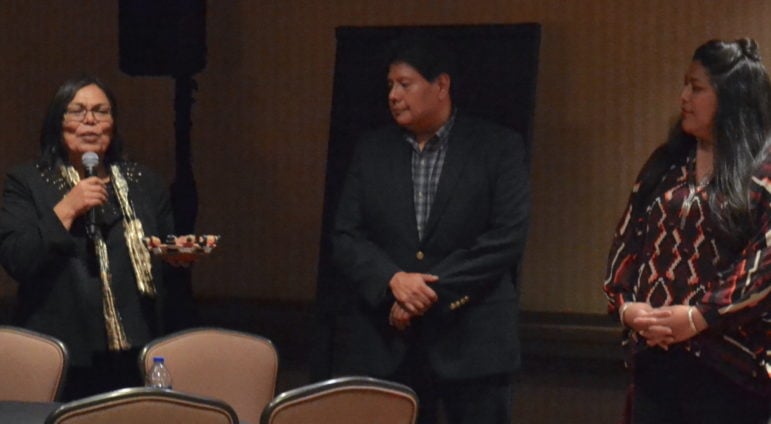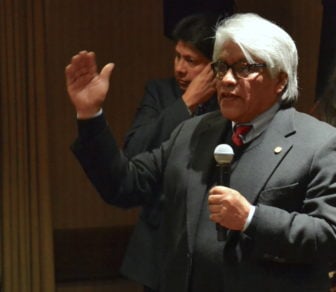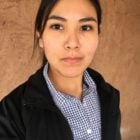
Melorie Begay
Executive Director Cheryl Fairbanks addresses the newly sworn in governors council. From left to right, Fairbanks, Ken Lucero, Phd, and Tara Gatewood.
A newly formed institute hopes that by synthesizing indigenous wisdom with hard-won knowledge of how American institutions work it can become a powerful advocate and resource for New Mexico’s Native American population.
The Native American Budget and Policy Institute, formed in late February at the Tamaya resort on the Santa Ana Pueblo, aims to create a dynamic dialogue drawing from both traditions.
Using a network of academics, policy makers and tribal elders, the Institute wants to strengthen the influence of Native Americans in policy making at the local, state and potentially federal levels.

Melorie Begay
Regis Pecos, a former governor of Cochiti Pueblo and one of the founders of the institute, speaks during the official launch.
The goal is to “create the kind of balance” that allows native peoples to “become architects of policy, the architects of laws where they are necessary” — all toward improving the lives of Native American children and their communities, said Regis Pecos, a former governor of Cochiti Pueblo and one of the Institute’s founders.
The Institute’s 11-member governing council seems to embody that vision.
Eight members on the governance council are Native Americans affiliated with seven of the state’s 22 tribes — Navajo, Isleta, Mescalero, Santa Clara, Zia, Cochiti, and Jicarilla. Their number includes college professors, a retired judge, a medical doctor, a mental health therapist, and a journalist.
There are non-native members, too — a business owner, an attorney and a former Ford Foundation program officer and longtime Massachusetts of Technology professor.
Diversity was a conscious decision, the Institute’s Executive Director Cheryl Fairbanks said.
“We gathered together people with expertise, not just from UNM, Princeton, or Harvard, but those with Indigenous knowledge to help us to work on policies and funding,” she said.
Statistics bear out the challenges ahead for the newly formed institute. New Mexico’s Native American children graduate high school at lower rates than other racial or ethnic groups and are at greater risk for having no health insurance and for suicide. They are more likely to live in high-poverty areas than children from other populations, too.
Among the Institute’s goals is to help policy makers understand the complex realities Native Americans live in and to raise awareness about them to the outside world.
It also wants to give native communities a greater voice in formulating policy and legislative proposals meant to address those realities and act both as a resource center and clearinghouse for ideas and policy solutions, institute staff said.
“We haven’t always had a place at the table…now it’s our turn, we’re not the Indian problem, we’re the Indian solution,” Fairbanks, said.
Members of the newly appointed governing council acknowledged the institute’s ambitions and said they were honored to be a part of the creation.
“It has tremendous potential,” Arthur Blaze, the president of the Mescalero Apache Tribe and a member of the Institute’s governing council, said. “It’s a very diverse and strong group.”
Like others on the council, Blaze has an extensive background in leadership at the tribal, state, and federal level.
In 2011, he was appointed by former U.S. President Barack Obama to serve as Deputy Under Secretary of Agriculture for Natural Resources and the Environment within the U.S. Department of Agriculture.
“We’re going to look at changing, modifying, or creating new policy that is going to enhance the tribes’ and Pueblos’ ability to provide quality services to tribal young people,” Blaze said.
Although Blaze has only served as Mescalero president for a month, he said he’s glad he agreed to be a part of the council.
“As a newly elected official, I see great value in [the institute] and look forward to working together,” he said.
Gayle Chacon, the former Surgeon General of the Navajo Nation, and another council member, spoke of the diverse council as “ingredients” that could lead to “something spectacular” despite the challenges to be encountered.
“We were the first people here, the indigenous people here. But we are the last to be included in anything,” Chacon said. “Everyone else is the last to know our history, our data.”
The last several centuries have imprinted on native peoples, including New Mexico’s 22 tribes, too, she said.
“It is translated in poor SAT scores, diabetes … the highest rates of suicide (for our children),” Chacon said.
But the challenges didn’t dim her hope for the future. It is important for native peoples — and the Institute as it forges its way — to keep asking meaningful questions such as “What it means to be healthy, what it means to be educated, what it means to live a good life,” she said.
Robert Yazzie, retired Chief Justice of the Navajo Nation, another council member, said tribal communities already possess the resources necessary to find the solutions.
“We have everything in place already,” Yazzie said. “We don’t need to invent new stuff to have a direction. We’ve always had a direction. Sometimes, we say we’re the last generation to really be able to see the Navajo worldview as is. Because we have the language, we have the experience, our kids don’t have the same benefit as we do.”
In a sense part of the goal is to communicate the worldview and deep culture of the communities to the younger generations, Yazzie said.
Michael Lipsky, another governing council member, brings a more western perspective to the governing council.
While at the Ford Foundation, where Lipsky was a program officer for years, he helped create “Honoring Nations,” a program that celebrates the achievements of American Indian nations in promoting excellence in governance through innovative programs, with Harvard University, according to a bio provided by the Institute. He also taught political science at the Massachusetts Institute of Technology for more than 20 years.
“In the states where Native people are a substantial part of the population, as they are in New Mexico..Native people are generally among the poorest,” Lipsky said.
Lipsky chairs the board of directors for the International Budget Partnership, an organization he helped create that works to reduce poverty through budget analysis and accountability.
“It’s good work, and important work to make clear what the government is doing on behalf of Native Americans,” he said.
“It’s an experiment to see whether the resources can be focused enough so that we can make an impact and we’re going to try,” he said.
Other members on the council are: Robert Apodaca, the Chief Operating Officer of Motiva Corporation, Hon. Walter Dasheno, former Governor of Santa Clara Pueblo, Tara Gatewood, host and producer of Native America Calling, Ken Lucero, Ph.D., field representative for Sen. Martin Heinrich, Patricia Salazar Ives, law partner at Cuddy & McCarthy LLP, Joseph Suina, Ph.D., UNM College of Education Professor Emeritus, and Ingeborg Vicenti, a mental health therapist.
————————————————————————————

Melorie Begay
Melorie Begay holds New Mexico In Depth’s reporting fellowship at the University of New Mexico for the academic year 2017/2018. As a journalist she’s interested in creating informative and engaging content through all forms of media. Outside of journalism her interests include drinking coffee, listening to podcasts, and accruing random facts from the internet.
Note: One of the Institute’s funders, the W.K. Kellogg Foundation, is also one of the funders of New Mexico In Depth.
Suicide as an alternative to living another day here on Planet Earth strikes a nerve with me. I see the act in western culture. From religious point of view to cultural. Death is every where.
Much of it stems from the western culture that capitalism brings. That there are winners and losers without equitable exchange. There lies the heavy burden on the psyche of the suicide victom.